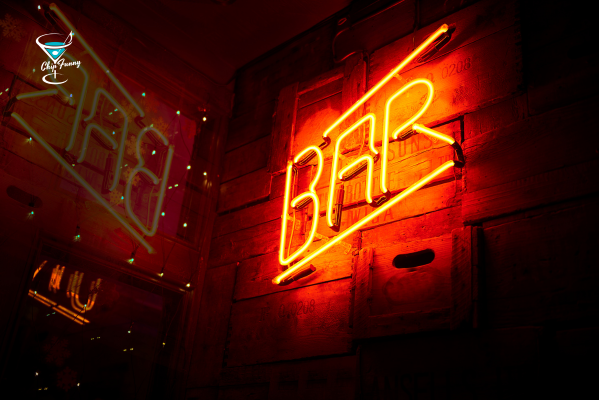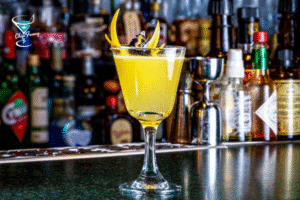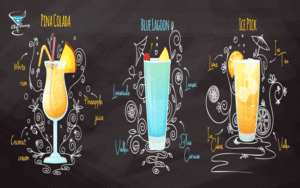When it comes to socializing and enjoying a night out, bars play a pivotal role in our culture. But what is a bar? At its core, a bar is an establishment that serves alcoholic beverages, often accompanied by a unique atmosphere and a variety of offerings. From cozy pubs to upscale cocktail lounges, the types of bars vary widely, each featuring distinct bar designs and menus that cater to different tastes. Essential bar equipment supports both the craft of bartending and enhances the overall experience. Join us as we explore the fascinating world of bars, from their diverse designs to the vibrant atmospheres they create.
1. What is a Bar?

A bar is an establishment designed primarily for the serving of alcoholic beverages. It often features a counter where patrons can sit and enjoy drinks, socialize, or interact with bartenders. Bars have evolved over time and can be found in various forms, each catering to different social experiences and preferences. Understanding what a bar is involves looking at its definition, purpose, types, and the atmosphere it creates for its patrons.
1.1 What is a Bar? Understanding the Concept of a Bar
A bar, in its most basic form, is a social venue where drinks are served, and patrons can gather for relaxation and enjoyment. The concept extends beyond just serving alcohol; it encompasses the entire experience of social interaction, entertainment, and often, a vibrant atmosphere. Key elements of a bar include:
- Counter Seating: A long bar counter where customers can sit and engage with bartenders.
- Drink Selection: A diverse menu that may include beer, wine, cocktails, and non-alcoholic beverages.
- Ambiance: Often lively and energetic, creating a space conducive to socializing.
1.2 The Primary Functions of a Bar
Bars serve multiple purposes that enhance the social experience for patrons. Some of the primary functions include:
- Social Interaction: Bars provide a relaxed environment for friends and strangers to meet and socialize.
- Entertainment: Many bars offer live music, electronic games, or other forms of entertainment that engage patrons.
- Culinary Offerings: While the focus is on drinks, many bars also offer a selection of food options, from snacks to full meals.
1.3 Different Types of Bars and Their Roles
Bars come in various types, each catering to different customer preferences and experiences. Here are some common types of bars:
| Type of Bar | Description |
|---|---|
| Sports Bars | Target sports enthusiasts; feature big screens, and often serve hearty food and drinks. |
| Wine Bars | Focus on a curated selection of wines, often with knowledgeable staff to guide selections. |
| Cocktail Bars | Specialize in crafted cocktails with unique ingredients and presentation. |
| Dive Bars | Casual, unpretentious spaces that often have a loyal local following. |
| Tiki Bars | Offer a tropical theme with exotic cocktails and a laid-back atmosphere. |
2. History and Evolution of Bars
2.1 The Origins of Bars Across Cultures
Bars can trace their origins back to ancient civilizations, where communal drinking spaces were integral to social life. Here are some key points about the origins of bars across various cultures:
- Ancient Egypt and Mesopotamia: The earliest known bars served beer, a staple drink of these civilizations. They were often located near temples and marketplaces, providing a space for socializing after work or worship.
- Greece and Rome: The Greeks and Romans popularized wine drinking in public spaces. Wine taverns, known as “tavernas” in Greece and “tabernae” in Rome, served as venues for philosophical discussions, political debates, and social gatherings.
- Medieval Europe: The rise of inns and taverns during the Middle Ages marked a significant development in the bar culture. These establishments catered to travelers and locals alike, offering food, drink, and a place to rest.
- Colonial America: In the 18th century, bars began to emerge in the American colonies, often referred to as “public houses.” They served as vital community hubs for social interaction and were crucial during events such as the American Revolution.
2.2 How Bars Have Changed Over Time
The evolution of bars has been marked by significant changes in design, offerings, and the overall atmosphere. Here are some notable transformations:
- Design and Atmosphere:
- Early bars were often dark and cramped, with a simple counter for service.
- Modern bars now focus on creating a welcoming ambiance, incorporating elements like mood lighting, comfortable seating, and themed decor to enhance the customer experience.
- Bar Menu Diversification:
- Historically, bars primarily served beer and basic spirits.
- Today, bar menus feature a wide variety of alcoholic beverages, including craft cocktails, premium wines, and specialty drinks, catering to diverse tastes.
- Technological Advancements:
- The introduction of modern bar equipment, such as cocktail shakers, ice machines, and draft beer systems, has revolutionized drink preparation and service.
- Technology has also influenced how bars engage with customers, using social media and apps to promote events and specials.
- Cultural Shifts:
- Bars have adapted to changing social norms and customer preferences.
- The rise of craft cocktail culture, for example, has led to a resurgence in mixology and the art of bartending, emphasizing quality ingredients and innovative recipes.
2.3 The Impact of Bars on Social Interactions
Bars play a crucial role in shaping social interactions and community dynamics. Here are some key impacts of bars on social life:
- Social Spaces:
- Bars serve as informal gathering places where friends, colleagues, and strangers come together, fostering connections and community ties.
- They provide an environment that encourages conversation and interaction, essential for building relationships.
- Cultural Exchange:
- Bars often reflect the culture of their location, offering a space for cultural exchange and diversity.
- For example, wine bars promote a culture of wine appreciation, while sports bars create a sense of camaraderie among fans.
- Celebration and Ritual:
- Bars are often central to celebrations, from birthdays to significant life events, providing a backdrop for memorable experiences.
- They also host rituals, such as happy hours or trivia nights, which encourage regular patronage and community engagement.
- Economic Contributions:
- Bars contribute to local economies by creating jobs and attracting tourism.
- They often host events and activities that draw in crowds, further enhancing their role in the community.
3. Popular Types of Bars

When discussing what is a bar, it’s essential to explore the various types that exist today. Each type of bar caters to different tastes, preferences, and social experiences, creating unique atmospheres and offerings. Here, we will delve into the most popular types of bars, highlighting their characteristics, ambiance, and appeal.
3.1 Overview of Pubs and Taverns
Pubs and taverns are traditional establishments that have been integral to social culture in many countries, particularly in the UK and Ireland. They serve as community gathering spots where patrons can enjoy drinks, food, and companionship. Let’s take a closer look at their features:
Characteristics of Pubs and Taverns
- Casual Atmosphere: Pubs are known for their laid-back environments, often featuring wooden furniture and cozy settings.
- Food Offerings: Many pubs serve hearty meals, such as fish and chips, burgers, and traditional dishes, making them popular for dining as well.
- Community Focus: Pubs often foster a sense of community, with regulars forming friendships and engaging in local events, trivia nights, and sports viewings.
3.2 The Rise of Cocktail Bars
In recent years, cocktail bars have gained immense popularity, evolving from simple drink-serving establishments to sophisticated venues that emphasize mixology and presentation. These bars cater to those seeking a refined drinking experience.
Key Features
| Feature | Description |
|---|---|
| Beverage Selection | Focus on handcrafted cocktails, premium spirits, and artisanal mixers. |
| Presentation | Drinks are often beautifully garnished and presented in unique glassware. |
| Social Environment | A chic and trendy atmosphere, perfect for socializing and celebrating. |
3.3 Specialty Bars: Wine, Beer, and More
Specialty bars focus on specific types of alcoholic beverages, providing enthusiasts with a curated experience tailored to their interests. This category includes wine bars, beer gardens, and whiskey lounges, each offering a unique ambiance and selection.
Characteristics of Specialty Bars
- Focused Beverage Offerings: Whether it’s wine, craft beer, or whiskey, specialty bars provide a diverse selection that caters to connoisseurs and casual drinkers alike.
- Expert Knowledge: Staff members are often well-versed in their specific beverage area, providing recommendations and insights to enhance the customer experience.
- Community Engagement: Many specialty bars host tastings, workshops, and events that foster a deeper appreciation for their featured beverages.
4. Bar Etiquette and Culture

4.1 Understanding Bar Etiquette for Patrons
When visiting a bar, knowing the appropriate etiquette can enhance your experience and help you connect with others. Here are some key points to consider:
- Be Respectful to Staff: Always treat bartenders and servers with respect. They work hard to provide for customers, and a polite demeanor goes a long way.
- Order Wisely: When at the bar, keep your order concise. If you’re unsure about what to order, consider asking the bartender for recommendations rather than making them go through a long list of choices.
- Tip Generously: Tipping is a significant part of bar culture. A standard tip is around 15-20% of your bill, but consider tipping more for exceptional service.
- Mind Your Space: Bars can be crowded, so be mindful of the space you occupy. Avoid leaning on the bar or crowding others who are also trying to order.
Tips for Patrons
| Tip | Description |
|---|---|
| Be Patient | Busy nights can lead to longer wait times; patience is key. |
| Avoid Phone Calls | Speak quietly or step outside if you need to take a call. |
| Respect Personal Space | Keep a respectful distance from others at the bar. |
| Know When to Leave | If you’re done with your drink, don’t linger too long at the bar. |
4.2 The Role of Bartenders in Bar Culture
Bartenders play a crucial role in shaping the bar experience, serving not only drinks but also as social facilitators. Their responsibilities extend beyond mixing cocktails—in many ways, they are the heartbeat of the establishment.
- Creating Atmosphere: Bartenders set the tone for the bar. A friendly bartender can elevate the mood, while a skilled bartender can craft extraordinary cocktails that keep patrons coming back.
- Knowledgeable Guides: They are often well-versed in the bar menu, including the types of bars represented, special cocktails, and the bar equipment used to create them. Don’t hesitate to ask for recommendations!
- Conflict Resolution: Bartenders are trained to manage conflicts that may arise among patrons, ensuring a safe and enjoyable environment for all.
- Building Community: Regular customers often form relationships with bartenders, creating a sense of community. This connection fosters a welcoming atmosphere for new guests.
4.3 Common Customs at Bars Worldwide
Bar customs can vary significantly from one culture to another, but certain traditions have become popular in many parts of the world. Understanding these customs can help you navigate bar experiences in different countries.
- Cheers Rituals: In many cultures, raising a glass and toasting is a common practice. For example, in Germany, it’s customary to maintain eye contact while clinking glasses.
- Happy Hour: Many bars offer discounted drinks during specific hours. This tradition can vary widely, from early evenings to late-night specials, depending on local customs.
- Bar Games: In some regions, bars may feature games like darts or pool, encouraging social interaction among patrons. Participating in these games can enhance the overall experience.
- Cash vs. Card: While cash is still king in many places, some bars have adapted to modern payment methods. It’s best to check in advance which payment methods are accepted.
CHIP FUNNY – Restaurant – Drink Chill & Eatery in Phu Quoc
🌐Webiste: http://chipfunny.vn/
🌆Address: No. 92 Tran Hung Dao Street, Duong Dong, Phu Quoc, Vietnam
📞Hotline: 091 631 75 55
✉️Email: chiplounge92@gmail.com











